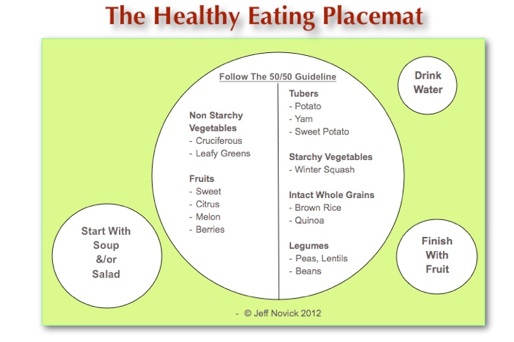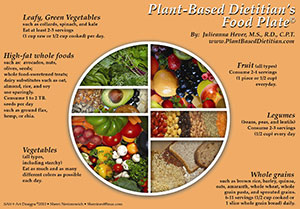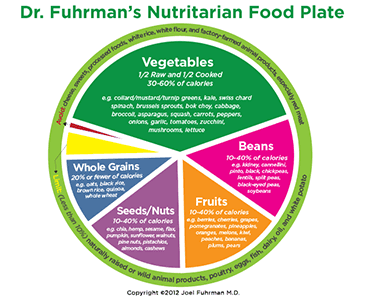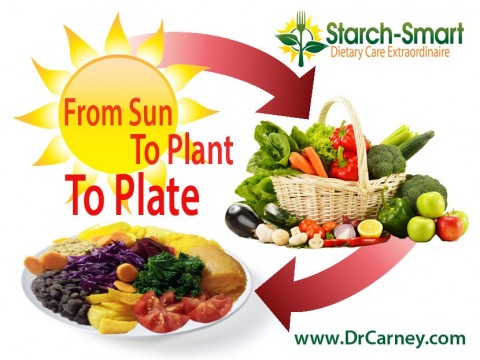DrCarney.com Blog
What Does a Plant-Based Dinner Plate Look Like?
 "I have really been thinking about . . . how best to describe the principles of a healthy diet, and I think, plant-centered, minimally processed, calorie dilute, low SOS [salt, oil, sugar] & variety, really sums it all up," says Jeff Novick, MS, RD. But what does that look like when we sit down to a meal? And is Jeff's definition the healthiest one out there? Let's see what other plant-based eating experts think about dividing up a dinner plate.
"I have really been thinking about . . . how best to describe the principles of a healthy diet, and I think, plant-centered, minimally processed, calorie dilute, low SOS [salt, oil, sugar] & variety, really sums it all up," says Jeff Novick, MS, RD. But what does that look like when we sit down to a meal? And is Jeff's definition the healthiest one out there? Let's see what other plant-based eating experts think about dividing up a dinner plate.
Jeff's "Healthy Eating Placemat" suggests that 50% of our plate should be filled with fruits and non-starchy vegetables. Sometimes these non-starchy vegetables are called "green and yellow vegetables." They can also be thought of as veggies that "crunch"-- that is, vegetables that are sometimes enjoyed raw although we might choose to eat them cooked instead. The other 50% of the plate, according to Jeff, should be filled with starchy foods like potatoes, sweet potatoes, winter squash, intact whole grains, and beans. Using Jeff's 50-50 rule as a basis for comparison, we can discover what other models of plant-based eating might look like.
The Power Plate
Neal Barnard, MD , and the Physician's Committee for Responsible Medicine (PCRM) suggests the "Power Plate." Not only does PCRM promote the plate because it offers "a scientifically proven approach to help prevent and manage our nation’s largest public health threats: obesity, type 2 diabetes, heart disease, and certain forms of cancer," but they say that a plant-based diet "is associated with less environmental impact than the current U.S. dietary patterns, according to the most recent Scientific Report of the 2015 Dietary Guidelines Advisory Committee." As we look at PCRM's plate, we see half the plate filled with fruits and vegetables (including starchy veggies like winter squash and potatoes), and the other half divided evenly between whole grains and legumes.
, and the Physician's Committee for Responsible Medicine (PCRM) suggests the "Power Plate." Not only does PCRM promote the plate because it offers "a scientifically proven approach to help prevent and manage our nation’s largest public health threats: obesity, type 2 diabetes, heart disease, and certain forms of cancer," but they say that a plant-based diet "is associated with less environmental impact than the current U.S. dietary patterns, according to the most recent Scientific Report of the 2015 Dietary Guidelines Advisory Committee." As we look at PCRM's plate, we see half the plate filled with fruits and vegetables (including starchy veggies like winter squash and potatoes), and the other half divided evenly between whole grains and legumes.
How does the Power Plate stack up against Jeff's Placemat? The balance between fruits/vegetables and starches is again 50-50. But because PCRM includes starchy vegetables in the category with other vegetables, a Power Plate might easily devote more than 50% of the space to starch. For example, if the Power Plate contained 25% beans, 25% brown rice, plus some baked butternut squash, there would be more starch on the Power Plate than on Jeff's Healthy Eating Placemat.
The Plant-Based Dietitian's Food Guide Pyramid and Food Plate
Julieanna Hever offers both the Plant-Based Dietitian's Food Guide Pyramid and Food Plate. Just over 25% of her plate is comprised of beans and whole grains, while the rest fills in almost entirely with vegetables and fruits; her vegetable category includes starchy vegetables. Interestingly, Julieanna highlights the nutritional importance of leafy, green veggies by giving them their own place on her plate.
offers both the Plant-Based Dietitian's Food Guide Pyramid and Food Plate. Just over 25% of her plate is comprised of beans and whole grains, while the rest fills in almost entirely with vegetables and fruits; her vegetable category includes starchy vegetables. Interestingly, Julieanna highlights the nutritional importance of leafy, green veggies by giving them their own place on her plate.
Putting Julieanna's Food Plate to the test against the Placemat, her meal might also have more than 50% starch, depending on what vegetables were chosen for that portion of the plate. However, since she dedicated space for green leafy veggies, Julieanna's assured that these nutrient dense vegetables won't get squeezed off the plate by a serving of sweet potatoes.
The Nutritarian Pyramid and Food Plate
Joel Fuhrman, MD , serves up the Nutritarian Pyramid and Nutritarian Food Plate. He suggests a percentage range for the different food categories on his plate, but even eating the lowest percentage from each category would leave nearly half the plate filled with fruits and vegetables. Whole grains and beans plus a few nuts or seeds would take up most of the rest of the plate. Says Dr. Fuhrman, "Ninety percent of the daily diet should be made up of nutrient rich plant foods, whose calories are accompanied by health-promoting phytochemicals: green and other non-starchy vegetables; fresh fruits; beans and legumes; raw nuts, seeds, and avocados; starchy vegetables; and whole grains." He explains that the remaining 10% of his plate can be comprised of minimally processed foods like tortillas, tofu, and coarsely ground or sprouted whole grain breads; he makes a reluctant allowance for animal products saying that they can only be eaten "rarely" and that they should preferably not comprise more than 5% of calories. Clearly, Dr. Fuhrman is emphasizing that health and healing lie in whole plant foods.
, serves up the Nutritarian Pyramid and Nutritarian Food Plate. He suggests a percentage range for the different food categories on his plate, but even eating the lowest percentage from each category would leave nearly half the plate filled with fruits and vegetables. Whole grains and beans plus a few nuts or seeds would take up most of the rest of the plate. Says Dr. Fuhrman, "Ninety percent of the daily diet should be made up of nutrient rich plant foods, whose calories are accompanied by health-promoting phytochemicals: green and other non-starchy vegetables; fresh fruits; beans and legumes; raw nuts, seeds, and avocados; starchy vegetables; and whole grains." He explains that the remaining 10% of his plate can be comprised of minimally processed foods like tortillas, tofu, and coarsely ground or sprouted whole grain breads; he makes a reluctant allowance for animal products saying that they can only be eaten "rarely" and that they should preferably not comprise more than 5% of calories. Clearly, Dr. Fuhrman is emphasizing that health and healing lie in whole plant foods.
The Nutritarian plan might be a little harder to pin down for comparison purposes. When we estimate the different percentage combinations, there is less emphasis on starches and more emphasis on fruits and vegetables. Another major difference is that none of the other plant-based nutrition experts makes an allowance for animal products because animal foods in any amount increase our risk of disease.
Starch is Smart
Sometimes a plant-based diet is ridiculed as "rabbit food." People picture eating (and "starving") on celery and carrots. John McDougall, MD, understands the concern. As part of the extended interviews for the movie Forks Over Knives, Dr. McDougall explains that unless we include a strong amount of starches on our plate, we will indeed feel as if we are "starving to death." Sustaining energy comes from legumes, intact whole grains, and starchy vegetables. All large, successful ancient civilizations were fueled by starch, says Dr. McDougall. "You must have the rice, the corn, the potatoes, the sweet potatoes, the barley. You must have starch as the center because this is high calorie vegetable food. You must have that energy." That's why on all the plant-based plates, more than half of it is made up of calorie-dense starches.
Despite the various plate presentations and the different graphics, plant-based doctors and nutritionists agree that optimal health and vitality comes from eating a balance of low-calorie and calorie-dense plant foods that are as minimally processed as possible. Did you notice the From Sun to Plant to Plate graphic at the opening of this article? The plate is actually just a photo of my Starch-Smart® breakfast one morning. If you'd like to see how other whole-food, plant-based, no-added-oil adherents eat, you might also enjoy perusing Lindsey Nixon's plate as well as Cathy Fisher's plates. You'll see that there are lots of delicious plant-based plates, but that all of them include a balance of starches and other vegetables or fruits. It's my hope that you'll be inspired to fuel your health, your happiness, and your healing with a hearty serving of plants on your plate!
Scroll Down Page to Leave Comments

Starch-Smart Social Networking
Join our Online Support Community at DrCarney.com/community featuring Starch-Smart Discussions, Blogs and more by signing up for a free membership to Dr. Carney's Community.
Preview the "Ask the Doc!" Trailer
Your Questions Answered: In Dr. Carney's Starch-Smart® System seminars, written questions from participants are collected beforehand, protecting their privacy. In this informative video presentation, Dr. Carney shares the answer to many of those frequently asked questions - with complex scientific evidence made easy to understand. Learn the answers to what you've always wanted to ask, and so much more!
When you subscribe to the blog, we will send you an e-mail when there are new updates on the site so you wouldn't miss them.




